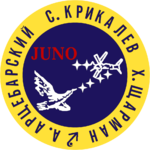Project Juno: Difference between revisions
m Added link |
m Minor factual addition |
||
| Line 20: | Line 20: | ||
Sharman was launched aboard [[Soyuz TM-12]] on 18 May 1991, and returned aboard [[Soyuz TM-11]] on 26 May 1991. |
Sharman was launched aboard [[Soyuz TM-12]] on 18 May 1991, and returned aboard [[Soyuz TM-11]] on 26 May 1991. |
||
Both Sharman and Mace were candidates but not selected in the 1992 and 1998 [[European Space Agency]] selection rounds for its astronaut corps. Mace did not fly in space, but married the daughter of [[cosmonaut]] [[Vitali Zholobov]]. He later was the [[helicopter]] pilot for [[President of South Africa]] [[Nelson Mandela]].<ref>[http://www.spacefacts.de/bios/international/english/mace_timothy.htm spacefacts.de]</ref> |
Both Sharman and Mace were candidates but not selected in the 1992 and 1998 [[European Space Agency]] selection rounds for its astronaut corps. Brooks was also put forward for the European Astronaut Corps in 1982, but dropped out when employed on AI systems elsewhere <ref>http://www.spacefacts.de/english/bio_cand.htm</ref>. Mace did not fly in space, but married the daughter of [[cosmonaut]] [[Vitali Zholobov]]. He later was the [[helicopter]] pilot for [[President of South Africa]] [[Nelson Mandela]].<ref>[http://www.spacefacts.de/bios/international/english/mace_timothy.htm spacefacts.de]</ref> |
||
==See also== |
==See also== |
||
Revision as of 22:09, 12 December 2015

Project Juno was a private British space programme, which selected Helen Sharman to be the first British Person in space.
As the United Kingdom has never had a human spaceflight programme, a private consortium was formed to raise money to pay the Soviet Union for a seat on a Soyuz mission to the Mir space station. The Soviet Union had recently flown Toyohiro Akiyama, a Japanese journalist, under a similar arrangement.
A call for applicants was publicized in the UK (one ad read "Astronaut wanted. No experience necessary"[1]), leading to 13,000 applications. Juno selected four candidates to train in the Soviet Union:
- Gordon Brooks (Royal Navy physician, then 33)
- Major Timothy Mace (Army Air Corps, 33)
- Clive Smith (Kingston University lecturer, 27)
- Helen Sharman (food technologist, 26)
Eventually Mace and Sharman were the two finalists, and Sharman was chosen for the flight with Mace as her backup.
The cost of the flight was to be funded by various innovative schemes, including sponsoring by private British companies and a lottery system. Corporate sponsors included British Aerospace, Memorex, and Interflora, and television rights were sold to ITV.
Ultimately the Juno consortium failed to raise the entire sum, and the Soviet Union considered canceling the mission. It is believed that Mikhail Gorbachev directed the mission to proceed at Soviet cost. Several of the ambitious microgravity experiments that were originally planned were eliminated in favour of experiments designed by British schools that could be done with existing equipment aboard Mir.
Sharman was launched aboard Soyuz TM-12 on 18 May 1991, and returned aboard Soyuz TM-11 on 26 May 1991.
Both Sharman and Mace were candidates but not selected in the 1992 and 1998 European Space Agency selection rounds for its astronaut corps. Brooks was also put forward for the European Astronaut Corps in 1982, but dropped out when employed on AI systems elsewhere [2]. Mace did not fly in space, but married the daughter of cosmonaut Vitali Zholobov. He later was the helicopter pilot for President of South Africa Nelson Mandela.[3]
